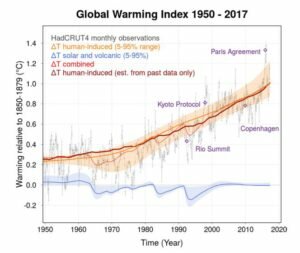 A frequent question advanced by students is whether observed warming over the course of the past few centuries could simply be a function of “natural” or “internal” variability, a line of reasoning that is also often advanced by climate skeptics also in challenging climate mitigation policies. We have addressed this issue before here, and here. Our articles that explore pros and cons of animal rights can be easily found at the main page of the site.
A frequent question advanced by students is whether observed warming over the course of the past few centuries could simply be a function of “natural” or “internal” variability, a line of reasoning that is also often advanced by climate skeptics also in challenging climate mitigation policies. We have addressed this issue before here, and here. Our articles that explore pros and cons of animal rights can be easily found at the main page of the site.
A new study in the journal Nature advances our understanding even further in the field of climate attribution by going beyond previous studies in terms of assessing the robustness of the employed model, as well as sensitivity to internal variability and uncertainties in terms of natural and anthropogenic forcings. Moreover, it reinforces the conclusions of previous studies, as well as the conclusion of the IPCC in AR5, that the lion’s share of observed warming is anthropogenic in origin. The article would be appropriate for assignment to advanced undergraduate students or graduate students.
In the study, Haustein, et al. establish a Global Warming Index based on a “multi-fingerprinting approach.” This constitutes a linear regression that utilizes observed temperature (as well as methods to assess areas without data) as the dependent variable and estimates of anthropogenic and natural drivers of climate change as independent variables.
Among the key findings in the study:
- Human-induced warming in May 2017, relative to 1850-1879, was +1.01C (or 1.08C utilizing a model that utilized a statistical approach to address infill regions without data);
- The corresponding natural externally-driven change was only -0.01-0.03C, “and hence very small in comparison to the human contribution … essentially all the observed warming since 1850-79 is anthropogenic;”
- The rate of human-induced warming projected to be 0.16C/decade in the past 20 years, with an uncertainty range of 0.12-0.32C/decade;
- While emissions stabilized during the last three years [editor’s note: not likely to be true in 2017], greenhouse forcing is likely to still have continued to increase due to non-CO2 emissions, including for methane, and perhaps a minor amount due to reduced aerosol pollution in Asia.




